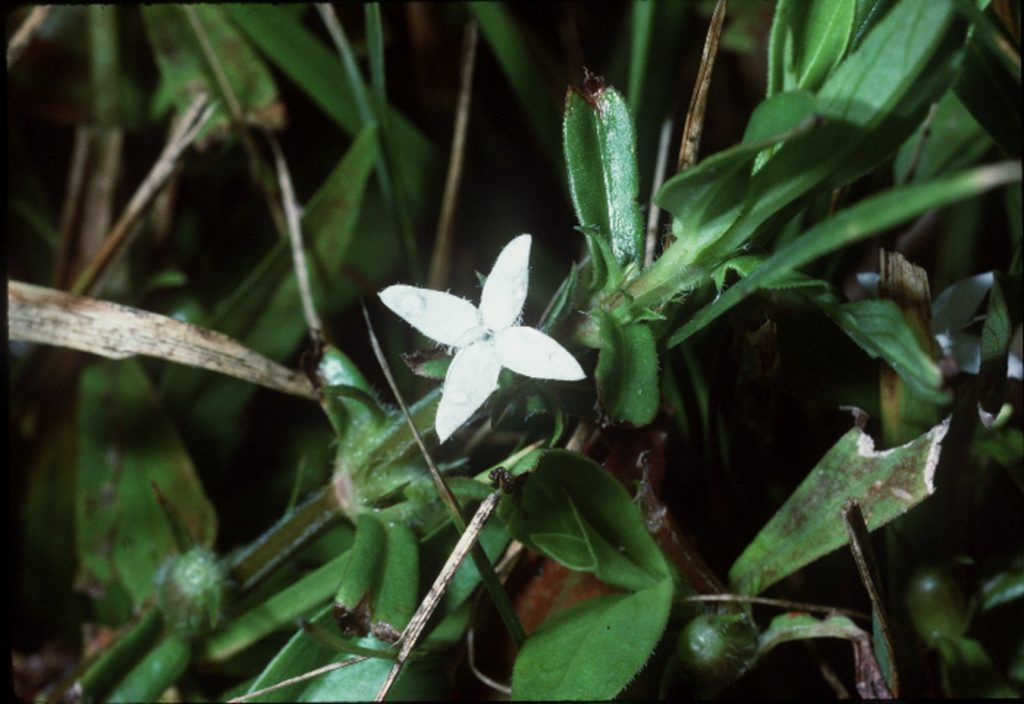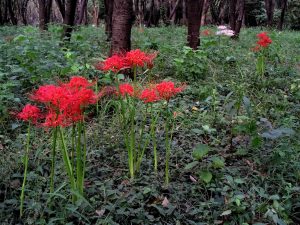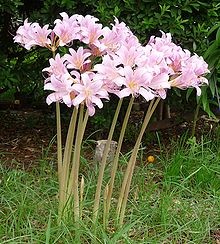Virginia Buttonweed (Diodia virginiana) is a common broadleaf weed that can be troublesome in both turfgrass lawns and ornamental beds.


Virginia Buttonweed (Diodia virginiana) is a common broadleaf weed that can be troublesome in both turfgrass lawns and ornamental beds.

As a result of this Monday’s storm, has the wet snow splayed some of your shrubs or bent over your trees?
Here is some good information from our neighbors to the south at NC State Extension on how to help your shrubs and trees recover from the heavy snow load. (Click linked image below.)


Virginia Cooperative Extension is once again cautioning the public to take measures to avoid spreading the devastating boxwood blight when decorating for the holidays this year. Do you know that boxwood greeneries and decorations could carry the boxwood blight pathogen to your property, destroying precious boxwood plantings that your family has had for generations and threatening those of your neighbors?
It’s easy to plant garlic in the fall!
Garlic can also be spring planted, but needs to be chilled first (refrigerate for at least 8 weeks before planting in spring). Garlic plants need to reach an adequate size before day length increases in the spring, which triggers bulb formation, so plant as early as possible in spring.
Continue readingMy Oak tree has a lot of brown leaves on it. Can you help me determine what is wrong?
What you see in the picture at the bottom are damaged leaves from a non-sting wasp. We commonly see the effects of Jumping Oak Galls this time of year. The amount of leaves impacted on each tree can vary.
We do not have any insecticide treatment options, but the galls have little impact on the tree health. As seen in these photos, the tree suffered almost complete defoliation from infestation, but on the right we see the same tree just a week later full of new leaves. Your tree should be able to care for its own health given time.
To relieve pressure for future years, you can remove all fallen leaves by bagging them and removing them from your property. This will keep some larva from maturing and affecting the tree in future seasons. Also, if drought occurs later in the season water the tree to help relieve stress that may be impacting the tree health.
Photos 1 & 2: Left, A white oak that was nearly defoliated as a result of a severe infestation of jumping oak gall; Right, This is the same tree a week or so later showing new leaves growing. Photo credits: Dave Filipiak
The brown spots that you see on the leaves are a form of a blister from the tiny seed-like galls located on the underside of the leaves. Each gall serves as an incubator for a single non-sting wasp.
The name Jumping Oak Gall comes from when the larva hits the ground. After the larva hit the ground, you can see them jumping about an inch off of the ground, trying to position themselves on the soil surface to survive the winter.
All resource links accessed May 31, 2018
Photos 1 & 2: Michigan State University Diagnostic Services, used with permission
Photo 3: Alice Cox, 2018 Henrico County Extension Summer Intern
Do you have a gardening question that the Henrico Master Gardener Volunteers can help you with? The Henrico Extension Master Gardener Horticulture Helpline provides expert advice and guidance on a variety of gardening topics.
The Henrico Master Gardener Horticulture Helpline can be reached at (804) 501-5160, which also serves as the main number for the Extension office. The helpline will be staffed from 12:30 to 4:30 p.m. Mondays and Fridays and from 9 a.m. to noon Tuesdays, Wednesdays and Thursdays through October.
In addition, the public may call from 8 a.m. to 4:30 p.m. weekdays to leave a message. A Master Gardener will respond during the next shift.
For the helpline, a team of volunteer Master Gardeners will have access to a vast library of Extension publications and information on horticulture topics. Henrico’s Master Gardener program provides education and promotes research-based information on horticulture to the gardening public. For more information, go to henrico.us/extension.
Answers provided herein were based on specific situations and growing conditions.These recommendations may or may not be appropriate for all circumstances.For specific recommendations for your particular situation please contact your local Cooperative Extension Office.
I have an oak tree that has a weird looking fruit on it. Can you help identify it?
Thanks for the pictures. What you see in the picture on the oak tree is a gall caused by a non-sting wasp. It is common among oaks to develop galls at this time of the year. Galls can vary in shape and size.
Galls are usually only cosmetic problems on the oaks. We do not have any treatment options for them. Once you see the gall, the insect is already inside the gall. So if there was a treatment, it wouldn’t get rid of the gall. If you want you can cut out the galls (again, non-stinging wasp, so no concern of getting stung). But I would just leave them. Usually we see galls for a couple of years on a tree, then we won’t see them again for many years, if at all, as part of natures cycles.
Galls are abnormal growths of plant tissue induced by insects and other organisms. Gall-making parasites release growth-regulating chemicals as they feed, causing adjacent plant tissues to form a gall. The parasite then develops within the relative security of the gall.
All resource links accessed May 8, 2018
Lynn Holterman, used with permission
Do you have a gardening question that the Henrico Master Gardener Volunteers can help you with? The Henrico Extension Master Gardener Horticulture Helpline provides expert advice and guidance on a variety of gardening topics.
The Henrico Master Gardener Horticulture Helpline can be reached at (804) 501-5160, which also serves as the main number for the Extension office. The helpline will be staffed from 12:30 to 4:30 p.m. Mondays and Fridays and from 9 a.m. to noon Tuesdays, Wednesdays and Thursdays through October.
In addition, the public may call from 8 a.m. to 4:30 p.m. weekdays to leave a message. A Master Gardener will respond during the next shift.
For the helpline, a team of volunteer Master Gardeners will have access to a vast library of Extension publications and information on horticulture topics. Henrico’s Master Gardener program provides education and promotes research-based information on horticulture to the gardening public. For more information, go to henrico.us/extension.
Answers provided herein were based on specific situations and growing conditions.These recommendations may or may not be appropriate for all circumstances.For specific recommendations for your particular situation please contact your local Cooperative Extension Office.
The fescue and/or bluegrass lawn that is so prevalent in Henrico is reliably winter hardy. However, while well adapted to winter, these cool season turf varieties may be injured in cold weather. There are a number of things that you can do and also not do to minimize the risk of winter turf damage.
BE ON THE LOOKOUT FOR THESE WINTER DISEASES:
Snow Molds: Snow molds are not nearly as big of a problem in Virginia lawns as they are further north. However, when they occur, they certainly attract a lot of attention. Following winters with extended snowfall, it is possible that cool-season lawn grasses have been attacked by either pink or gray snow mold. The blighted turf will be a circular patch of varying size of matted down turf. The diseases are more likely to occur on succulent turfgrass leaves that received very high levels of fall Nitrogen fertilization; so again, proper fall fertilizer is key. It is not generally recommended that home lawns be treated for snow molds because the disease is rarely going to kill turf in this setting. Use a heavy garden rake to work up the matted turf in the affected areas in order to increase air and moisture movement into the turf canopy. Observe the area over the next 7 days or so to see if new shoots are emerging from the crowns. If you don’t see any signs of new growth after that time period, then plan on reseeding these areas.
Red Thread or Pink Patch: Spring-like temperatures and plenty of moisture result in ideal conditions for turfgrass diseases to make an appearance in lawns, particularly cool-season grasses. The disease present is likely one of two things: Red thread or Pink patch. The bright red to pink mycelial growth of this fungus is plainly visible early in the morning, particularly when the dew is still on the grass. The disease will remain an eyesore as long as cool, moist periods persist, but the fungus only attacks the foliage and rarely will the entire plant die. What should you do to manage this disease? Almost always, the proper treatment is to leave it alone rather than applying a fungicide. As the weather warms and dries, red thread and pink patch will gradually disappear.
Part 1 of this series can be found here.
Part 2 of this series can be found here.

Carlton Hines, 2017 Henrico Master Gardener Intern
Lycoris is a flowering plant and perennial herb from the Amaryllis family. It is known commonly as the resurrection lily, surprise lily, spider lily, and/or hurricane lily. It grows by bulb, and never bears leaves and flowers at the same time. Its leaves are strap or lance-shaped, its flowers contain three to six petals, and their fruits are either in the form of fleshy berries or dry capsules.

Photo Credit: By Blue Lotus – Flickr, CC BY 2.0, https://commons.wikimedia.org/w/index.php?curid=1215482
Blue-green foliage grows in the fall through spring from a bulb, then dies back to the ground without a single bloom. After “taking much of the summer off” they suddenly erupt with growth. Within a 5-day period, they reach heights of 18 inches, boasting circular clusters of 2-inch-long flowers. The backward curving sepals and petals, combined with long, upwardly arcing pistols and stamens, resemble a spider. The flowers bloom for several weeks, coinciding with hurricane season. Only two species of Lycoris are readily available in the United States, which are Lycoris radiata and Lycoris squamigera.
Lycoris radiata are the least winter hardy species, growing in USDA Plant Hardiness zones 6-10. Bulbs require 9” spacing with the top ¼” exposed. They grow 12”-18” tall with an equal spread. Red, non-fragrant, showy flowers bloom between August and September in full sun to part shade with medium water requirements and medium maintenance. Flowers will prefer some shade in warmer climates. The naked flower scapes bear an umbel and 4-6 light coral red flowers. Leaves appear in fall, overwintering and lasting through spring. L. radiata are not prone to pest and insect damage.
Lycoris squamigera are more cold hardy, growing in USDA Plant Hardiness zones 5-9. Bulbs should be planted 5”-6” deep and spaced 6” apart. They grow 12”-18” tall with an equal spread. The naked flower scapes begin their growth in late summer to bear 4-7 funnel-shaped flowers that are fragrant and rose pink in color. Flowers bloom August to September in full sun or part shade with medium water requirements and low maintenance. L. squamigera is called the “magic lily” and is found typically in shady woodlands. Plants are not prone to pest and insect damage.

Photo Credit: By Namazu-tron (Self Shot) [GFDL (http://www.gnu.org/copyleft/fdl.html) or CC BY-SA 3.0 (http://creativecommons.org/licenses/by-sa/3.0)], via Wikimedia Commons
In warmer regions, growth begins in fall, enduring through spring. In colder regions leaf growth starts in spring. Leaves die back without too much of a mess, leaving a nitrogen-rich food source for its bulb. Harsh winters may diminish flower hardiness, which can prevent them from flowering the following summer. If growing in pots, bulbs require a large growing space with potential for deep root development. Containers that are too small will cause “failure to thrive” syndrome and not flower at all.